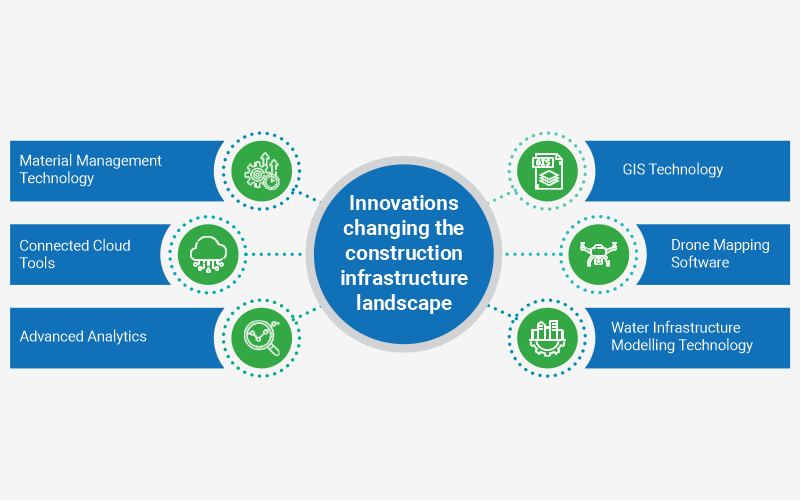Last Updated on November 23, 2023 by softtech
In the era of development, the AEC industry has progressed a lot. The population upsurge has triggered the need for advanced infrastructure. To capitalize on the rising infrastructure demand, construction companies must move quickly & innovate like never before. Taking the business-critical steps to enhance your tools and processes today will allow the construction industry to win when the project requirements come along. Experts at SoftTech recommend some tools and technologies making waves today, and they will certainly be influential in the future.

Connected Cloud Tools
Cloud-connected tools have improvised the construction management of projects. The tool aids in streamlining the work processes and keeps teams connected through the hybrid module. The cloud-connected tools offer safer data storage and easy management of project reports. The cloud-connected tools also help generate progress reports and data insights from the collected information. The cloud tools have enabled construction firms to plan projects and execute them efficiently and cost-effectively easily.
Opticon is a cloud-based construction tool that uses integrated modules to provide ERP solutions. Opticon serves as a flexible decision-making tool. The software was designed to meet the company’s future goals and offer digital solutions to problems. It enables easy bidding, project management, transaction approvals, project cost estimation, hybrid working, and also manages project schedules. In addition, the software also helps with financial accounting, client invoicing, progress monitoring, machinery checks, inventory management, sales, CRM, and payroll management.
Material Management Technology
Material management is a crucial step of construction projects. Mismanagement of the materials drains the company’s budget and lands with over-expenditure issues. On the other hand, an efficient material management strategy aids in cost-cutting and improves project efficiency. At the same time, bad material management can cause project delays, give rise to safety issues, and reduce profit margins.
The material management technology helps to manage the logistic requirement for multiple projects. For example, infrastructure projects require large quantities of machines, building materials, tools, and equipment. An effective material management tool helps keep track of material requirements, purchase, supply, and usage. The tools also help to make economical purchases of high-quality materials. In addition, the management tools help evaluate the cost associated with various materials, thus enabling cost-cutting.
Apart from these, construction material management technology also handles the following functions:
• Handles scheduling and transportation of materials
• Performs quality control
• Performs storage and inventory management
• Handles onsite material transport
• Waste management
• Increases worker productivity
• Eliminates duplicate material purchase
• Lowers material damage risks
• Improves the project budget
• Helps in accomplishing project deadlines
Advanced Analytics from the Field
The AEC industry produces a wide range of data. Manual recording and optimization of this data prove to delay the work. The manual procedure also induces the risk of errors in estimation and calculation. That is when advanced analytics comes to aid. The data analysis helps in the planning, designing, and decision-making processes. Advanced data analytics aids the teams in deriving relevant data from the collected information to achieve project profits. Furthermore, advanced data analytics helps evaluate the risks and issues faced in a project. Beforehand optimization of the risks helps find relevant solutions, thus contributing to project progress.
The key benefits offered by data analytics include:
• Speeding up project progresses
• Tracking real-time financial data
• Monitoring operational patterns
• Generating budget and project progress reports
• Eliminating data collection errors
• Removing site accidents
• Accessing real-time safety data
• Generating more profitability
• Enabling better competition
• Tracking proposal submission
• Improved billing
• Optimizing subcontractor performances
• Easy work schedule analysis
Drone Mapping Software
Drones or Unmanned aerial vehicles(UAV) have undergone many advancements over the years. Drones have seen much usage in the heavy civil construction industry for drone mapping and reporting. The drones help survey plots, plan projects and fetch real-time worksite data. The drone mapping allows the stakeholders to visualize and analyze the construction project. It also helps to track the inconsistencies between render models and site work. The drone technology assists with designing, monitoring, and management.
Some of the advantages offered by drone mapping software include:
Automating construction project lifecycle
The drones help to streamline the onsite data collection and autogenerate project documents. The digitalized data gives stakeholders and project managers an accurate reading of the work completed.
Supporting multidimensional project management
Drones help control the design, schedule, and material requirements for various projects. The multidimensional reports help save time and cut costs for the company.
Delivering high-end engineering and managerial analytics
The drone mapping offers accurate engineering data and process analytics. The drone data helps to auto generate survey grade models, site maps, and project reports and compare various design ideas.
Existing construction project progress compatibility check
The drone technology helps to integrate the construction project process and applications. This process helps to find hassle-free compatibility issue solutions.
Site safety measure analysis
The drones map the site and check for dangerous accident-prone areas like roads, bridges, and structures. The sites also help analyse the site safety measures like a fire alarm, smoke indicator, machine fault detectors.
Increasing business profitability
Drone mapping helps to automate project monitoring and data analysis. It also helps to find the overall project execution costs, thus doubling project profitability.
GIS Technology
Computerized mapping of locating through GIS technology dates back to the 1960s. Back then, it was used primarily for land resource planning. Later on, its usage was commercialized, and effectiveness was applied to various domains worldwide. The geographic information system is used for managing geographic data. The system helps find the nearby streets, buildings, vegetation, medical centres, hospitals, malls located around the site. The system aids in designing projects accordingly and finding pricing for it. Some GIS software also helps build 2D and 3D maps of the sites. The technology is also utilized for refining project plans and designs based on user reviews. GIS is a tool used for planning, monitoring, and managing construction activities for real estate developers. In addition, the analytics reports generated through GIS helps in customizing the user experience through charts and histograms.
Water Infrastructure Modelling Technology
While building any project, it is essential to analyse the water reports of the grounds. Projects offering a good water supply have higher pricing. Knowing the importance of water, water infrastructure modelling technology was developed. The technology helps find water contamination issues, lead toxin deposits, groundwater level, water table, and water hardness. In addition, the software helps offer high-end water infrastructure solutions.
Some of the prime benefits offered by the water infrastructure modelling technology include:
Analysing the water quality
The technology helps to find chlorine and fluoride residuals present in the water. It also helps to find the water movement, concentration, and quality.
Develop unidirectional flushing programs
The technology helps develop fire hydrant flushing sequences that ensure that water delivered to the consumer tap is of high quality. It also ensures that the water is free of color and sediment deposits.
Prepares emergency response plans
The technology helps o draft response plans during emergencies such as water scarcity, fire, or water contamination. The recovery plans help identify the various sources of water for the site and check the water volume.
The infrastructure projects in modern times are way more advanced. Therefore, exploring these innovative tools and teaching them in the projects would level up the game of the AEC industry.
About Author
Olivia Jones
Technology Specialist
Olivia is a highly skilled and experienced Technology Specialist with 10+ years of hands-on expertise in the rapidly evolving field of technology. She has a proven track record of successfully implementing and managing a wide range of technological solutions, ensuring optimal performance and efficiency. Olivia possesses a deep understanding of industry trends and emerging technologies, enabling her to provide strategic guidance and drive innovation within organizations. With a strong focus on problem-solving, she consistently delivers tailored solutions that align with business objectives while maximizing productivity and cost-effectiveness.
About SoftTech Engineers
A leading IT company (www.softtech-engr.com) facilitating business and technology transformation across the AEC industry through innovative software products and solutions. Equipped with 25+ years of deep domain expertise and industry knowledge, SoftTech has helped more than 4500 clients & government organizations, with more than 25000 users in India and around the world to gain a competitive edge and lead from the front in the industry.

